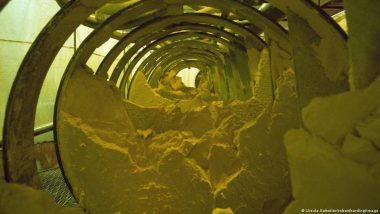Think radioactive and you may think nuclear energy, atomic weapons — things that are there but not there. Uranium, however, is all around us — in rocks, water, air.Uranium was discovered in 1789 by Martin Klaproth, a German chemist. It is a radioactive element found naturally in the environment in very small amounts — scientists call these trace amounts — in rock, soil, water systems, such as streams, on plants and as dust in the air.
What does uranium look like?
Also Read | LVM3 Rocket Places 36 OneWeb Satellites in Orbit; Boost for ISRO's Human Space Mission, Says S Somanath.
Uranium has the same silver-white-gray finish as other heavy metals, such as lead, cadmium or tungsten. And it too is very dense.
The International Atomic Energy Agency (IAEA) calculates that a 10-centimeter (3.93 inch) cube of uranium weighs about 20 kilograms (44 pounds).
Uranium in the environment
You can probably find it in the soil in your backyard. The IAEA says the average concentration of natural uranium in soil is two parts per million, which equals about 0.0002%. That's what you might call a trace amount.
As dust in the air, uranium can settle on the surface water of rivers, streams and lakes and then find its way to the bottom of the water, where it mixes with natural uranium already there.
Livestock consume uranium when they feed on grass, but it is quickly shed again through urine and feces.
What is uranium used for?
When uranium is not of the natural variety, it can be either "enriched" or "depleted."
Enriched uranium is used as fuel for nuclear power plants and the nuclear reactors that run naval ships and submarines. It also can be used in nuclear weapons.
Depleted uranium is used for radiation shielding or as projectiles in armor-piercing weapons.
Is uranium in drinking water?
Uranium can also get into groundwater. The World Health Organization (WHO) says "intake through drinking water is normally extremely low."
But that depends on the concentration of uranium in the water you drink. The IAEA says that in some parts of the world concentrations can be very high and that this results in much higher intakes of uranium from drinking water than from food. For example, consumption of uranium in parts of Finland can be tens of micrograms per day.
Whether that is carcinogenic for humans is unclear. The WHO says there is insufficient data from human and other animal laboratory studies.
How dangerous is uranium?
Uranium can be life-threatening, but that, too, depends on your exposure to it.
If you're exposed to uranium in the environment, outside of your body — what experts call external exposure — the risk to your health is low.
Uranium decays as alpha particles and the skin can block such particles.
Alpha particles are relatively slow and heavy compared with other forms of nuclear radiation and are unable to penetrate very deeply or through matter.
If, however, a person ingests a high concentration of uranium, it can cause cancer, affecting bones or the liver. And if a person inhales a large concentration of uranium, the alpha particles are likely to cause lung cancer.
Uranium is also a toxic chemical, so any form of consumption will damage a person's organs severely, particularly the kidneys.
Leaking uranium from industry and mining
Some of the uranium in the environment runs off from industrial works. Some of it gets into the atmosphere through mining.
The majority of the world's production of uranium from mines is from Kazakhstan, Canada and Australia. But it is also mined in Niger and Namibia.
Edited by: Jon Shelton
(The above story first appeared on LatestLY on Mar 26, 2023 10:50 PM IST. For more news and updates on politics, world, sports, entertainment and lifestyle, log on to our website latestly.com).













 Quickly
Quickly












